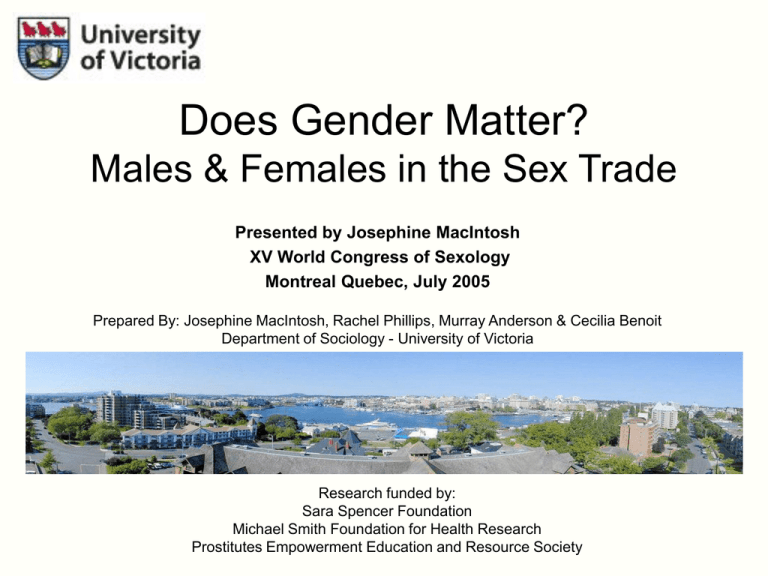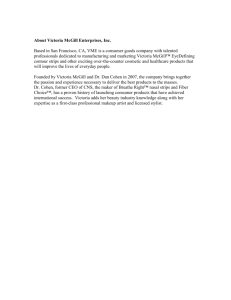
Does Gender Matter?
Males & Females in the Sex Trade
Presented by Josephine MacIntosh
XV World Congress of Sexology
Montreal Quebec, July 2005
Prepared By: Josephine MacIntosh, Rachel Phillips, Murray Anderson & Cecilia Benoit
Department of Sociology - University of Victoria
Research funded by:
Sara Spencer Foundation
Michael Smith Foundation for Health Research
Prostitutes Empowerment Education and Resource Society
Objectives
Explore gender differences & similarities
in a non-random sample of sex industry
workers situated in Victoria, BC, Canada
Explore whether male privilege common
in most jobs holds true for male STWs
– e.g., higher earnings, more occupational
control, lower morbidity
To explore the effects of gender on
– Worker experiences
University of Victoria, BC, Canada
Methods and Data
•
•
•
•
Project initiated by community
partner: Prostitutes
Empowerment Education and
Resource Society (PEERS)
Community-academic
collaboration; employed
experiential research assistants
Sample Size for this Report:
113 respondents located in the
Victoria Region
Work Status: All active in STW
Gender: 90 females, 23 males
Diverse research tool including
closed ended (n=201) and openended (n=79) questions on a
range of topics.
Work Location: majority of
respondents had worked in a
variety of venues, including
both indoor and outdoor sex
work.
Full Report: Benoit and Millar
(2001) Dispelling Myths and
Understanding Realities
University of Victoria, BC, Canada
Results
Demographic similarities by gender
–
–
–
–
–
–
Age (mean = 33 yrs; range 19 – 61 yrs )
Ethnicity (White)
Education (Completed grade 10)
Length of time living in the city (10 yrs)
Age turned first trick (21 yrs)
A few reported forced involvement
• None defined as part of global trafficking
Similar family backgrounds
University of Victoria, BC, Canada
Results
Differences in sexual identity by gender
– Overall, 46% self-identified as sexual minorities
– However, male STWs much more likely to selfidentify as a belonging to a sexual minority
Males
Females
Heterosexual
22%
62%
Sexual minority
78%
38%
F (1, 113) = 13.29, p < .001
University of Victoria, BC, Canada
Results
Reasons for Entering the Sex Trade
– Economic duress: Males 4%; Females 39%
• Bills, kids to feed, no job, ineligible for welfare
“No money, no means, no other choice”
Female, 42, street
– Enticement: Males 61%; Females 26%
• Easy money, opportunity,curiosity
“Just being curious, opportunities, people offering
me opportunities”
Male, 29, home
University of Victoria, BC, Canada
Results
Frequency of STW
– Vast majority report STW as main job
• Males more home-based, females more street & agency
Annual Income from STW
– Mean = $22,900 (just above f/t minimum wage)
• Males = $16,800; Females = $24,600 less control over $
– Similar levels of income, near minimum wage
Annual Income from Other Work
– Mean = $4,600
• Males = $9,000; Females = $3,500
– Males report more non-sex trade income
University of Victoria, BC, Canada
Results
Occupational Control
– Females report less control over money
– Genders report similar levels of control over (p > .05)
•
•
•
•
•
•
•
Career in the long term
Having sex with more than one John at one time
Number of clients per shift
Place where sex trade activities are performed
Type of sexual activities performed
Condom use
Hours worked and time off
Both genders reported “a lot” or “full” control
University of Victoria, BC, Canada
Results
Both genders report
– Control over their own sex trade activities
• Sometimes with a partner in the trade
– Control increases with experience
– Consistent condom use for penetrative sex
– High rates of injuries at work
• 48% of males and 53% of females had sought
treatment for injuries incurred in the sex trade
• Females report more gonorrhea & chlamydia
University of Victoria, BC, Canada
Results
Attractions of the Sex Trade
Males
Females
Money
26%
54%
Independence/Control
48%
34%
Enjoyment of sex
9%
3%
Skills to do the job
4%
0%
Satisfaction/Belonging
13%
2%
Other
0%
2%
Nothing
0%
3%
χ2 (6) = 15.14, p < .05
University of Victoria, BC, Canada
Conclusions
Male STWs report
– Similar demographics, backgrounds & experiences
– Similar earnings and occupational control
• Male privilege does not appear to function
– More paid work outside of the sex industry
– Less driven by economic need
• More job opportunities = male privilege
– Different reasons for entry
– Different attractions to the trade
• Many males appear to explore the sex trade
• Most women seem to resort to it
University of Victoria, BC, Canada
Ongoing Research
Interactive Service Workers Occupational Health
and Safety and Access to Health Services Study:
Victoria, BC and Sacramento, CA.
– Principle Investigator: Cecilia Benoit, University of
Victoria
A longitudinal comparative model is used to
overcome the limitations of cross-sectional data.
This new study examines occupational experiences,
health and health care access across sex work
populations and between sex work populations and
other lower-income service workers.
University of Victoria, BC, Canada
Contact Information
Josephine MacIntosh
University of Victoria
E-mail: jmm@uvic.ca
University of Victoria, BC, Canada
Acknowledgements
Foremost, we would like to thank the sex workers
who participated in the interviews that inform this
report. Without their voices, this project would not
have been possible
In addition, a special thanks goes to our experiential
research assistants who devoted not only their time
and energy to the project, but also a dedication to
extend and deepen our understanding of sex
workers’ lives
University of Victoria, BC, Canada
Acknowledgements
We also thank the following organizations:
–
–
–
–
–
–
–
–
Sandy Merriman House
The Needle Exchange
AIDS Vancouver Island
BC Health Research Foundation
Capital Health Region
BC Centre of Excellence on Women’s Health
University of Victoria
PEERS
University of Victoria, BC, Canada








